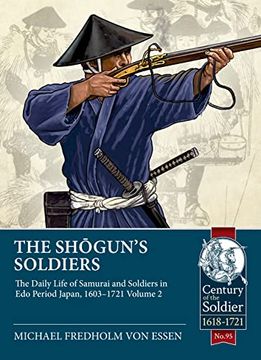The Shogun's Soldiers: Volume 2 - The Daily Life of Samurai and Soldiers in EDO Period Japan, 1603-1721 (en Inglés)
Reseña del libro "The Shogun's Soldiers: Volume 2 - The Daily Life of Samurai and Soldiers in EDO Period Japan, 1603-1721 (en Inglés)"
Details the organization, arms, armor, dress, and daily life of samurai, soldiers, and commoners in Edo-period Japan.Tokugawa Ieyasu's decisive victory at Sekigahara in 1600 concluded the civil wars, confirmed his position of military supremacy as shôgun (generalissimo) of Japan, and inaugurated the Edo period (1600-1868), so named because Ieyasu after the battle established his capital in Edo (modern-day Tokyo). By then, Japan was an advanced, outward-looking country. Previously preoccupied by internal warfare, Tokugawa-ruled Japan was unified, strong, and technologically developed to a degree inferior to Europe only in certain sciences, such as shipbuilding and artillery. Japan was technologically superior in some disciplines, including the production of firearms, an import the Japanese had mastered very quickly. Japanese traders, mercenaries, and adventurers were a common sight in South-East Asia. There were flourishing Japanese overseas colonies, especially in the Philippines, Siam (now Thailand), and Java. One Japanese merchant-adventurer even managed to set himself up as a minor kingin southern Siam. Japan was a strong military power as well. The armies of Japan were a match for any enemy, well armed and with considerable combat experience. However, the government of Japan in 1635 retreated into enforced seclusion, a seclusion aided by the geographical situation of the Japanese islands. The seclusion laws were rigorously enforced. As the Age of Enlightenment, the Industrial Revolution and the subsequent global expansion of the European nations transformed the world, Japan chose isolation and stagnation. A major reason for this policy decision was military weakness. The Tokugawa army under Ieyasu had been numerically large, experienced, and well equipped, but since then, things had changed. Having defeated their enemies early in the century, the shogunate warriors settled down in castle towns. Many Tokugawa retainers settled permanently in Edo, where they soon lost the military edge they had once enjoyed. After 1615, the shôgun's soldiers were no longer needed for war. Technically there was no demobilization, however, with no more wars to fight, the shôgun's soldiers became townsmen in all but name. They retained samurai status but were no longer called up to fight. Yet, a Tokugawa army of sorts still existed. Volume Two continues the examination of the Edo period and the evolution of the Samurai class into a verity of new roles. No longer required to fight, many Samurai firstly discarded their distinctive armor and then their training. As a result, a transformation from warrior to townsman took place. New careers were adopted, with many becoming part of the respected Firewatch or police force. Former Samurai also became part of the justice system and ultimately were responsible for the carrying out of criminal sentences. The book finally seeks to understand the decline of Japanese martial prowess and that of the Samurai as a class with their integration into civilian society.

